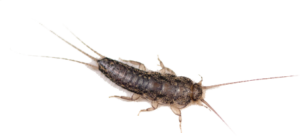Silverfish
Getting rid of silverfish can be a difficult task. They are nocturnal creatures that normally roam homes late at night, in search of food and water. Their flat bodies make them ideal hiders capable of squeezing into even the smallest cracks and crevices during daylight hours.
Before you decide how to get rid of silverfish in your home, you will have to confirm the enemy and its hiding spots. Silverfish and firebrats are both common in homes and look similar to each other. Both belong to the most primitive order of insects and are marked by carrot-shaped bodies and long antennae.
"The common silverfish, Lepisma saccharina, is shiny, silver or pearl gray, and about 1/2 inch long, although it can grow as long as 3/4 inch. The common firebrat, Thermobia domestica is shiny, a mottled gray or brown, and about 1/2 inch long. Adults of both species are slender, wingless, soft-bodied insects with 2 long, slender antennae... Their bodies taper gradually from front to rear to 3 long, thin, tail-like appendages. Although small nymphs (those that are less than 1/8 inch long) lack scales, both large nymphs and adults have them. If you see scales around or beneath damaged items, it is a good indication that these pests are the culprits."
To help get rid of silverfish, you should first monitor the infestation in your home, we suggest the following:
"Since silverfish are nocturnal, you usually won't see them. To detect and monitor infestations, Zeropest Australia use monitoring sticky trap stations. The insects climb into the monitoring station and can't climb back out. Place these traps or jars in corners and along edges where foraging is likely. Because these insects can travel long distances while looking for food, it can be difficult to pinpoint the infestation source."
How to Help Prevent Silverfish
Prevention is key to avoiding many infestations. The best way to control a silverfish population and limit future infestations is to develop a prevention plan.
Zero pest Australia recommends the following steps:
- Reduce food sources. Keep cereals, flour, meal, pastas, pet foods, and pet treats in airtight containers. Vacuum carpets, flooring, and upholstered furniture regularly.
- Reduce water sources. Use dehumidifiers in damp basements. Install plastic sheeting on the ground in dirt crawl spaces and ridge vents in roofs let humid air escape. Keep exterior areas caulked and well painted, gutters and downspouts free of debris, and landscaping graded to allow water to drain away from your home.
- Reduce harborages. Seamless interior walls limit access to sites such as wall interiors and spaces between ceilings and walls. Bristletails can gain access to these harborages through crevices and cracks under and behind baseboards, windows, and door trim and holes in walls and floors where pipes pass. Use caulking, spackle, or expandable foam to eliminate these openings.
Silverfish removal normally requires the application of insecticides. A Zeropest Australia technician should always handle this type of insect control. A Zeropest Australia technician can help develop a strategy for dealing with silverfish infestations and preventing future outbreaks. Zeropest Australia technicians are ready to help you get rid of moths and prevent moths from coming back.
We can figure out how silverfish have entered your home and will get into the dark corners of closets, attics or basements to find their food source. We will also schedule and provide the right silverfish treatment for your home.
Zeropest Australia offer silverfish treatment that will remove silverfish and we can help prevent them from coming back, 100% PEST FREE GUARANTEE* & 100% SATISFACTION GUARANTEE*.


